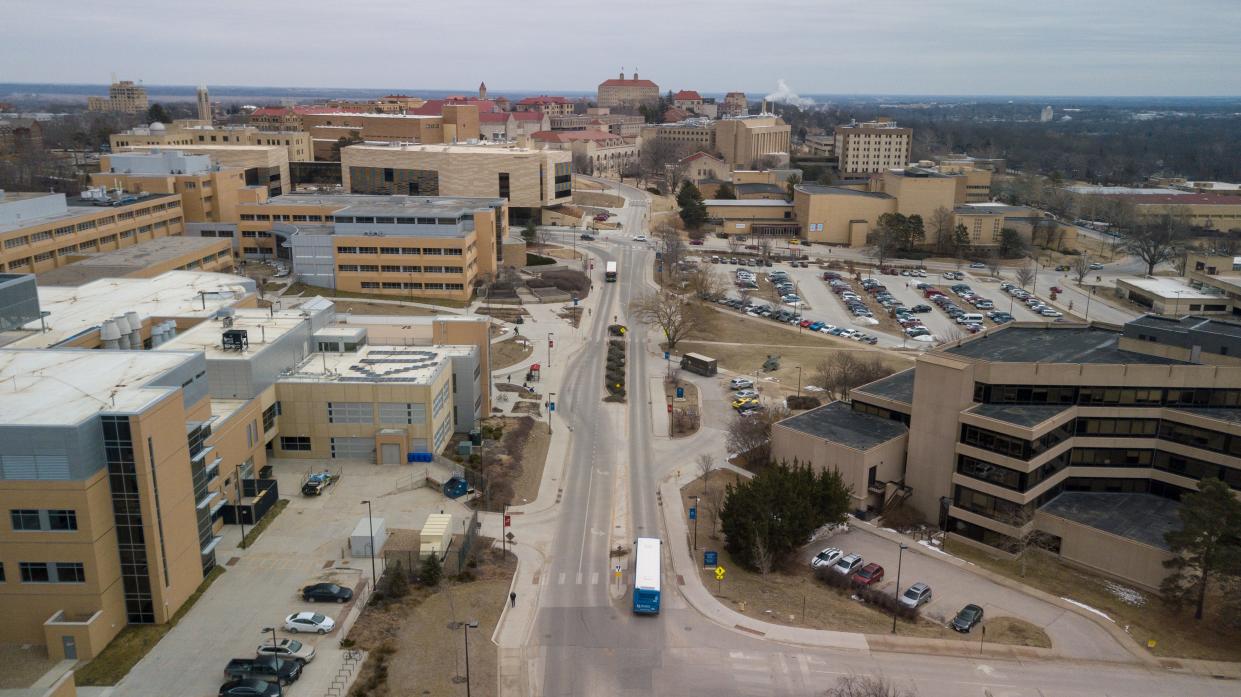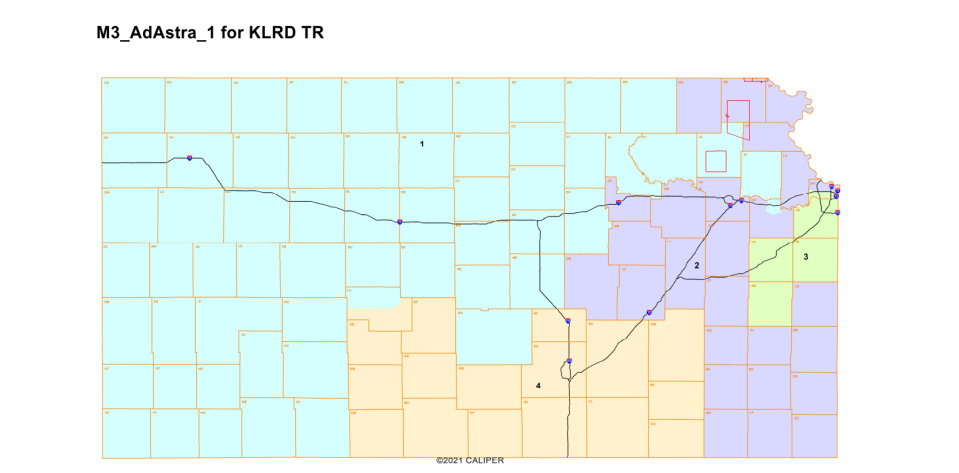Critics worry over plan to lump Lawrence with other college towns — and rural western Kansas

On the surface, the only thing Lawrence and Plainville likely have in common is a shared admiration for Jared Casey, the University of Kansas football player who caught the game-winning pass to beat Texas last November and who hails from the tiny town in Rooks County.
But if Republican legislators have their way, the two will be lumped into the 1st Congressional District together, even though they sit three-and-a-half hours apart.
All the while, Lawrence would be surrounded on three sides by the 2nd Congressional District, where it currently resides. While more rural and exurban swaths of Douglas County would remain in the 2nd District, the state's most prominent college town would exit.
The result is a move that could help solidify the control of U.S. Rep. Jake LaTurner, R-Kan., on the district, even though it would include parts of the Kansas City, Kan., area under a proposed, Republican-drawn Congressional map released earlier this week.
More: Proposed Kansas redistricting maps clear Senate, with Gov. Laura Kelly, courts waiting in the wings
The Kansas Senate approved the map introduced by top Republicans, dubbed "Ad Astra," Friday, just three days after they were formally introduced.
While the districts will likely meet opposition from Gov. Laura Kelly and a potential legal challenge, the stage is set for Lawrence to become a strange bedfellow with dozens of western Kansas communities.
"It dilutes or virtually eliminates our voice as far as being able to speak to the unique qualities or the unique needs of this community to help us thrive and really make the most contribution to the state's economy," said Hugh Carter, vice president of external affairs for the Lawrence Chamber of Commerce.
Does the proposed move hurt University of Kansas students?
Lawrence's complete inclusion in the 2nd District is not gospel — between 2002 and 2012, the eastern chunk of the city was in the 3rd Congressional District, which includes the Kansas City-metro counties of Wyandotte and Johnson.
When the maps were redrawn by a panel of three federal judges in 2012, Lawrence was moved into the 2nd District in its entirety, with Manhattan — previously included with Lawrence in that district — moved to the 1st District.
Now, the state's two most prominent college towns would be in one district, something Senate President Ty Masterson, R-Andover, used as a selling point for the map.

"I don't know how you wouldn't contest Lawrence and Manhattan aren't similar interests," Masterson said during a Senate hearing on the maps Thursday.
But of all the states with multiple Congressional districts, only Oregon includes its two largest public universities in one seat.
Paul Davis, a Lawrence attorney who ran as a Democrat in the 2nd District in 2018, said this could actually be a detriment, rather than a boost, to the University of Kansas and Kansas State, as it would divide the attention of a single lawmaker.
And it would also water down the influence a lawmaker has in helping Haskell Indian Nations University, which is a federally run facility under the Bureau of Indian Affairs.
More: Residents, advocates decry proposed Kansas maps as lawmakers advance GOP-authored proposal
"Sometimes members of Congress only have so many chips that they can play," Davis said. "So it's got to divide those chips among a couple of institutions. Things become more difficult."
Davis Hammet, executive director of Loud Light, a civic engagement group targeted at young Kansans, said the idea of pairing the University of Kansas and Kansas State was not a bad one in theory.
But the rural nature of the 1st District had the effect of watering down the voting impact of college-age residents, Hammet said, meaning a member of Congress would be less inclined to hear the concerns of young people.
"If you're not even trying to reach out to young voters they get less engaged, they get less invested in our community and they are more likely to leave our community," he said.
While KU, Kansas State and Fort Hays State would be in one districts, some of the state's other institutions of higher education would be spread out, something Emporia State students told legislators they didn't want to see happen.
Emporia State, Pittsburg State and Washburn University all would sit in the 2nd District under the proposed maps.
"The importance of keeping communities of interest — in this case, institutions of higher education — can help drive political interests toward these counties that mean so much to them,” Abe Lemus, a junior at Emporia State, told legislators during a town hall in the city last year.
More: As legislators embark on redistricting effort, Kansas' political future hangs in balance
‘This is gerrymandering — Kansas should play fair’

The Lawrence Chamber of Commerce has a partnership with their counterparts in Manhattan — but also chambers in Topeka and Emporia as well.
"What is good for Lawrence, from a state perspective is probably good for Manhattan in a lot of cases," Carter said. "I don't think that we strengthen our voice, though, by going into a district with so little similarities."
Because many of the services provided in Douglas County were a joint effort between the county and city of Lawrence, Davis said their lobbying would also be further complicated.
Patricia Willer, chair of the Douglas County Democratic Party, said the split would make it harder on elections officials in the county.
Ironically, the more rural corners of Douglas County will remain in the 2nd district, while Lawrence — where 80% of the county's population is housed — will move to the more rural district.
Willer noted, however, that while much of Douglas County is agricultural, it is very different than the type of communities housed in the 1st District.
"The 'Ad Astra' plan is drawn to weaken any hope of the 2nd Congressional District and the 3rd Congressional District from holding competitive elections," she said. "This is gerrymandering — Kansas should play fair."
More: Move most of Lawrence to 1st District? Ad Astra plan doesn't make sense for Kansas.
‘Lawrence is not going to be represented’
Whether the political competitiveness of the 2nd Congressional District will be meaningfully impacted by the move, however, is up for debate.
Davis said it would likely make the district less accessible for Democrats going forward. The most heavily conservative parts of the district remain — deep red Leavenworth County and the southeast corner of the state.
"It would be a very difficult district for a Democrat to be competitive," he said.
But Patrick Miller, a professor of political science at the University of Kansas, disagreed, arguing the addition of the northern tier of Wyandotte County made the proposal a "wash" politically for LaTurner, who was first elected to represent the 2nd District in 2020.
The Wyandotte County precincts, which will move to the 2nd District range in their characteristics but Miller noted they include heavily African-American voting areas that are heavily Democratic — but see lower turnout.
There is no doubt, however, that the 1st District will remain deeply Republican, even with Lawrence included in its midst.
More: Packed week of Kansas redistricting town halls kicks off absent Census data
This has led to criticism from Democrats that it effectively dilutes the voting power of minority residents in Lawrence, where 25% of residents are non-white. In the proposed 1st District, only 19% of the voting age population is non-white.
"Racial equity is lessened and that would have a significant impact," Willer said.
Masterson said the move was simply a matter of math and a necessary response to having to divide Wyandotte and Johnson counties.
"It makes logical sense, it made demographic sense and it just worked out," he said.
Still, U.S. Rep. Tracey Mann, who currently represents the 1st District, "could afford to never step foot in Lawrence for the next decade," Miller said and still see himself re-elected with relative ease.
But that doesn't necessarily mean a major change from the status quo, he added, given Lawrence's current location in a relatively conservative district.
"I think it's kind of a naïve question to ask how is Lawrence going to get represented," Miller said. "Lawrence is not going to be represented. Is Lawrence even represented now, with the representation that we have, and the politics of this community?"
Andrew Bahl is a senior statehouse reporter for the Topeka Capital-Journal. He can be reached at abahl@gannett.com or by phone at 443-979-6100.
This article originally appeared on Topeka Capital-Journal: Redistricting map puts Lawrence, KU into western Kansas district

